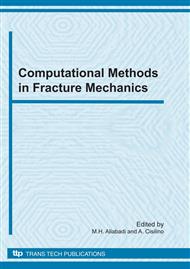p.1
p.11
p.31
p.47
p.79
p.97
p.113
p.127
p.137
Computer Modelling of Dynamic Fracture Experiments
Abstract:
In this work the time-domain boundary element method (BEM) is applied to simulate dynamic fracture experiments. The fast fracture is modelled by adding new boundary elements at the crack tip. The direction of crack growth is perpendicular to the direction of maximum circumferencial stress. The time dependent loading of specimens and velocities of crack growth are taken from experiments as input data for computer simulations. The method is used to analyze: a short beam specimen, a special mixed-mode specimen and a three-point bend specimen subjected to impact loads. The dynamic stress intensity factors (DSIF) and the crack paths are compared with the results obtained by other authors who used the finite element method (FEM) and experimental methods.
Info:
Periodical:
Pages:
113-125
Citation:
Online since:
December 2010
Authors:
Price:
Сopyright:
© 2011 Trans Tech Publications Ltd. All Rights Reserved
Share:
Citation:


